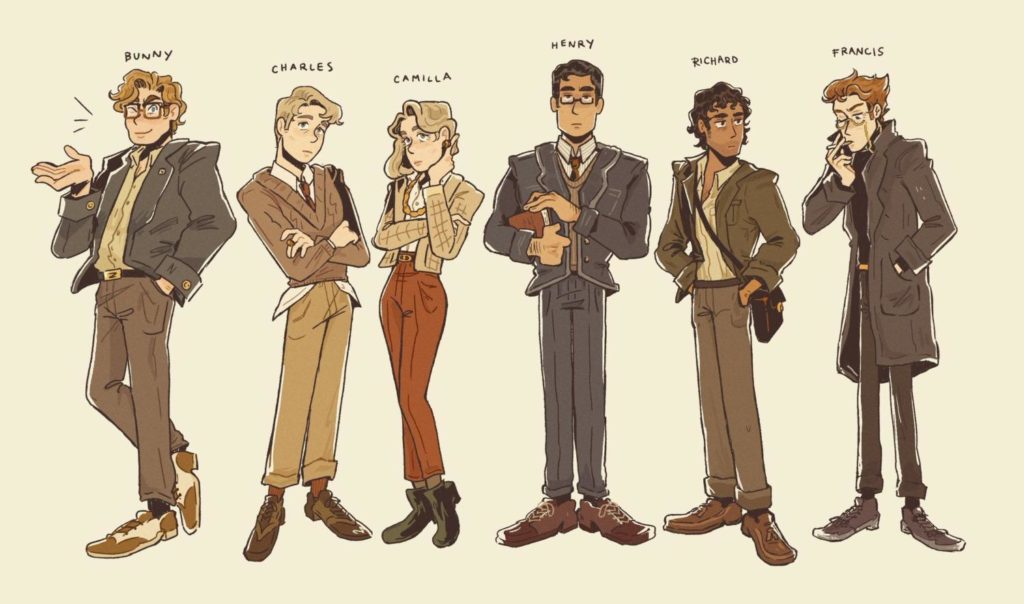Dark undertones of coffee-ladened brown, pages slipping between your fingers as you sit below the shining, swinging chandelier in a college library– this is the dark academica aesthetic. As it sits at the top of Pinterest boards, this romanticized way of living has become a cultural phenomenon, and is increasing in popularity as generations move past. There’s something else behind that golden hue or that sweater vest—think of Dead Poets Society—that makes this take on romanticism so enticing, and The Secret History by Donna Tartt encapsulates that perfectly.
Freshly 18, Richard Papen is a shy, bored young man from Plano, California. He finds himself being done with the way his life is going there, and so when he receives an invitation to Hampden College (a small, elitist university in Vermont), he doesn’t hesitate to catch the next plane over. There, he meets a group of collegiate, high ranking students in the form of a group of 5: Henry Winter, Edmund Corcoran, Camilla Macaulay, Charles Macaulay, and Francis Abernathy. The peculiar situation concerning them is that they’ve become the outcasts of the Hampden campus, considering that they only take ancient Greek and are stuck with the same professor (Julian Morrow), and their exclusive clique does not open to anyone at all—except for Richard. Once he gets in, he’s in for life, and things tend to go south rather quickly. One thing leads to another, and suddenly Edmund Corcoran is dead at the hands of his friends.
What separates Tartt’s writing style from most of the other cookie-cutter cliché storylines about trusting no one is her amazing development of their—now 6—friendship circle. Richard’s dynamic with each and every member of the clique is undoubtedly different, and the way that that development is set up in the novel is just incredible. For example, Tartt has Richard narrating the story in the past tense, and with every flashback, Henry Winter’s stone-cold, dangerously—he’s lost a few marbles—intelligent nature seems to make Richard feel as if he’s a god of some sort. Richard worships the ground he walks on, and every scripted flashback scene shows the development of Richard becoming more willing to get into trouble and to not question the psychotic means of Henry. Another example of Tartt’s fundamental characterization is with Camilla, Richard’s love interest. The dynamic between them is a mix of awkwardness and acknowledgement: they’re both aware of their feelings for one another, however the circumstances with Edmund (Bunny—his nickname) seem to get in the way of a blooming relationship. Camilla’s guilt for her part in Bunny’s death creates a wall between the two characters full of mysteriousness, and Richard falls apart at the seems in the sense that he no longer knows her anymore.
The Secret History is a take on a murder mystery story, however, it’s collegiate nature separates it from the rest. The scary, cult-like society that stands in the middle of New England is chilling, and the cunning nature of most of Richard’s friends gives the story a golden, gilded glamor. Besides Tartt’s undoubtedly charismatic characterization, the plain addictiveness of the twisted nature of this story is what makes it so enticing. In the same way that many lovers of true crime stories fixate on the genre, the slight horror as you flip every page in this novel is fascinating. It plays on human psychology, that we tend to veer (sometimes—depending on the person) towards topics that are heavy, and that require a lot of emotional processing. Tartt knows this, as she easily gives so much substance to Richard’s weird tendency to follow along with the group, even though he understands that references about Greek tragedy and inevitable death aren’t exactly commercial. This horror-story-like despicableness is so addicting, and the rising heartbeat you experience while waiting with bated breath to find out what happened next is exhilarating. Quite normally, this introduction of horror-story plots isn’t common in genres outside of horror, nevertheless, Donna Tartt does an excellent job at merging the two genres together. It’s extremely clean, the written diction is fantastic, and the plot isn’t messy by all means. There’s a point to be made when a dark academia aesthetic is combined so well with a story that comments on elitism.
For lovers of novels, the process of choosing a book to read can be difficult at times, especially when you have many viable options on your reading list. Naturally, books with a fantastic synopsis are often enough to make the cut. Tartt’s novel about radical human nature, combined with elements of Greek tragedy, horror, and elitism in the dark academia fashion is one of a kind. So the next time you think about entering a library for whatever reason, bring a tan trench coat, a cup of hot coffee, and give this book a read.
